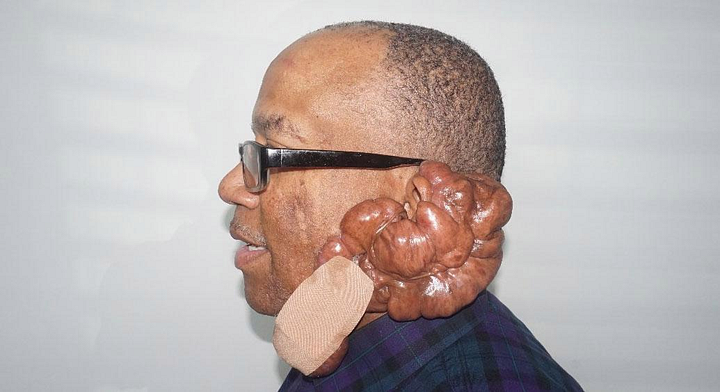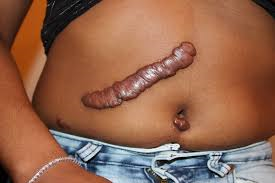
The picture above is that of a man named Keith Crowell who developed Keloid scars more than twelve years ago after a barber accidentally cut him on both sides of his neck. The Keloid scars grew so big, they weighed more than 40 pounds. I would love share with you some important facts about keloid which you may not know.
What are Keloid Scars?
A Keloid scar can be described as a raised scar formed after an injury has healed completely. It is usually puffy in appearance and has a shiny look. Normally, when the skin is damaged or cut, the body produces collagen which helps in repairing the damaged skin. While some research says the cause of Keloid is not known, a few believe it is due to overproduction of the required amount of collagen needed to restore the skin back to normal. Keloid could occur in various forms ranging from very small to very large and it is usually pink or red in colour.

Aside from Keloid scar, there are other kinds of scar which includes: Atropic scars (from acne and chicken pox), hypertrophic, contracture scar(from burns). Another unique feature of Keloid scar is that it grows beyond the site of injury. They most commonly grow on the shoulder, neck, breastbone, upper chest, back, earlobes and face (around jaw line).
What are the risk factors for keloid
Normally, people who develop Keloid are usually dark people. Scientists say there is a gene in the pigment of their skin that makes them prone to keloid scarring. Rarely do light people have it. Most types of skin injury can contribute to keloid scarring which include: Acne scars, burns, chicken pox scars, piercing the skin, scratches, surgical incision sites, insect bites, vaccination sites. So, it really does not depend on the severity of the wound.
Treatment and prevention of Keloid
Currently, there is no complete effective way of treating Keloid or to prevent their formation. Traditionally, surgical removal of scars is recommended. However, 45–100% of people will have a recurrence of the scar if surgery is not combined with other treatment and the new scar could be larger and more prominent than the original scar. Based on research, people who have treated keloid with home remedies tend to show significant improvement than people who use other therapies though that particular area may still look different in comparison with the rest of the body even after treatment. Home remedies that can be applied include: Aspirin, Garlic, onions and honey. (you can surf the net for details on how to apply them).
To prevent Keloid, avoid unnecessary surgery, avoid tattoos and piercing and also avoid skin picking and pimple popping.
Keloids are completely harmless. Having them shouldn’t affect your health because their impact is purely cosmetic. Home remedies can help a bit with keloid but keep in mind that no matter the method used to treat Keloid, once they are gone, they have high chances of returning. The best bet for anyone is to prevent it.
Thanks for reading.
#Stay healthy with Goodness
www.medicinenet.com: Keloid scar treatment, prevention, remedies symptoms and causes.
www.healthline.com- Keloid scars: Symptoms, causes and treatments.
www.healthline.com- How to get rid of old scars.
www.aad.org- Keloids: Diagnosis and treatment.
www.uofmhealth.org- Keloid scars
Comments
Post a Comment